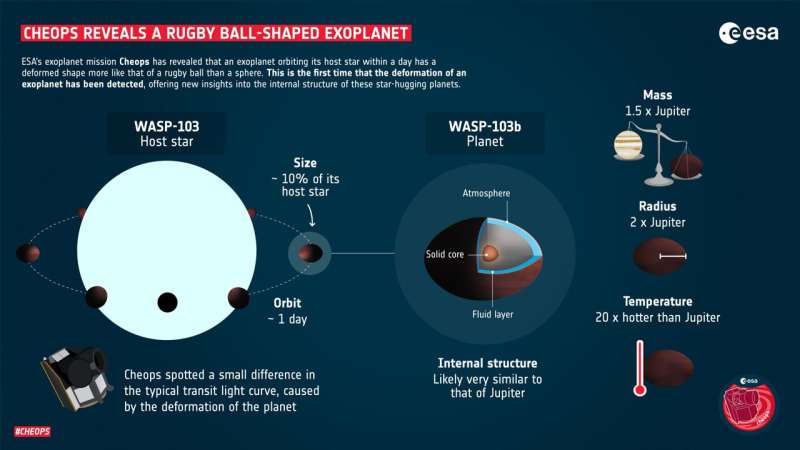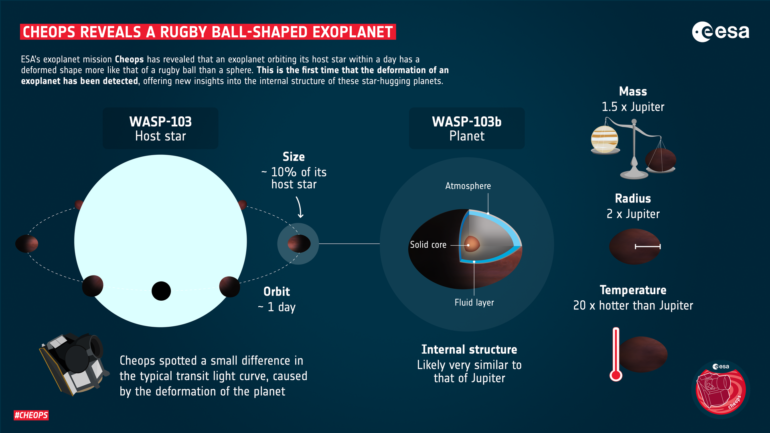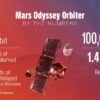ESA’s exoplanet mission Cheops has revealed that an exoplanet orbiting its host star within a day has a deformed shape more like that of a rugby ball than a sphere. This is the first time that the deformation of an exoplanet has been detected, offering new insights into the internal structure of these star-hugging planets.
The planet, known as WASP-103b is located in the constellation of Hercules. It has been deformed by the strong tidal forces between the planet and its host star WASP-103, which is about 200 degrees hotter and 1.7 times larger than the sun.
Tidal tug
We experience tides in the oceans of Earth mainly due to the Moon tugging slightly on our planet as it orbits us. The sun also has a small but significant effect on tides, however it is too far from Earth to cause major deformations of our planet. The same cannot be said for WASP-103b, a planet almost twice the size of Jupiter with 1.5 times its mass, orbiting its host star in less than a day. Astronomers have suspected that such a close proximity would cause monumental tides, but up until now they haven’t been able to measure them.
Using new data from ESA’s Cheops space telescope, combined with data that had already been obtained by the NASA/ESA Hubble Space Telescope and NASA’s Spitzer Space Telescope, astronomers have now been able to detect how tidal forces deform exoplanet WASP-103b from a usual sphere into a rugby ball shape.
Cheops measures exoplanet transits—the dip in light caused when a planet passes in front of its star from our point of view. Ordinarily, studying the shape of the light curve will reveal details about the planet such as its size. The high precision of Cheops together with its pointing flexibility, which enables the satellite to return to a target and to observe multiple transits, has allowed astronomers to detect the minute signal of the tidal deformation of WASP-103b. This distinct signature can be used to unveil even more about the planet.
“It’s incredible that Cheops was actually able to reveal this tiny deformation,” says Jacques Laskar of Paris Observatory, Université Paris Sciences et Lettres, and co-author of the research. “This is the first time such analysis has been made, and we can hope that observing over a longer time interval will strengthen this observation and lead to better knowledge of the planet’s internal structure.”
Inflated planet
The team was able to use the transit light curve of WASP-103b to derive a parameter—the Love number—that measures how mass is distributed within a planet. Understanding how mass is distributed can reveal details on the internal structure of the planet.

ESA’s exoplanet mission Cheops has revealed that an exoplanet orbiting its host star within a day has a deformed shape more like that of a rugby ball than a sphere. This is the first time that the deformation of an exoplanet has been detected, offering new insights into the internal structure of these star-hugging planets. © European Space Agency
“The resistance of a material to being deformed depends on its composition,” explains Susana Barros of Instituto de Astrofísica e Ciências do Espaço and University of Porto, Portugal, and lead author of the research. “For example, here on Earth we have tides due to the Moon and the sun but we can only see tides in the oceans. The rocky part doesn’t move that much. By measuring how much the planet is deformed we can tell how much of it is rocky, gaseous or water.”
The Love number for WASP-103b is similar to Jupiter, which tentatively suggests that the internal structure is similar, despite WASP-103b having twice the radius.
“In principle we would expect a planet with 1.5 times the mass of the Jupiter to be roughly the same size, so WASP-103b must be very inflated due to heating from its star and maybe other mechanisms,” says Susana.
“If we can confirm the details of its internal structure with future observations maybe we could better understand what makes it so inflated. Knowing the size of the core of this exoplanet will also be important to better understand how it formed.”
Since the uncertainty in the Love number is still quite high, it will take future observations with Cheops and the James Webb Space Telescope (Webb) to decipher the details. The extremely high precision of Webb will improve the measurements of tidal deformation of exoplanets, enabling a better comparison between these so-called “hot Jupiters” and giant planets in the Solar System.
Mysterious motion
Another mystery also surrounds WASP-103b. The tidal interactions between a star and a very close-in Jupiter-sized planet would usually cause the planet’s orbital period to shorten, bringing it gradually closer to the star before it is eventually engulfed by the parent star. However, measurements of WASP-103b seem to indicate that the orbital period might be increasing and that the planet is drifting slowly away from the star. This would indicate that something other than tidal forces is the dominant factor affecting this planet.
Susana and her colleagues looked at other potential scenarios, such as a companion star to the host affecting the dynamics of the system or the orbit of the planet being slightly elliptical. They weren’t able to confirm these scenarios, but couldn’t rule them out either. It is also possible that the orbital period is actually decreasing, rather than increasing, but only additional observations of the transits of WASP-103b with Cheops and other telescopes will help shed light on this mystery.
“The size of the effect of tidal deformation on an exoplanet transit light curve is very small, but thanks to the very high precision of Cheops we are able to see this for the first time,” says ESA’s Project Scientist for Cheops, Kate Isaak. “This study is an excellent example of the very diverse questions that exoplanet scientists are able to tackle with Cheops, illustrating the importance of this flexible follow-up mission.”
More information:
S. C. C. Barros et al, Detection of the tidal deformation of WASP-103b at 3 σ with CHEOPS, Astronomy & Astrophysics (2021). DOI: 10.1051/0004-6361/202142196
Provided by
European Space Agency
Citation:
Cheops reveals a rugby-ball-shaped exoplanet (2022, January 11)



